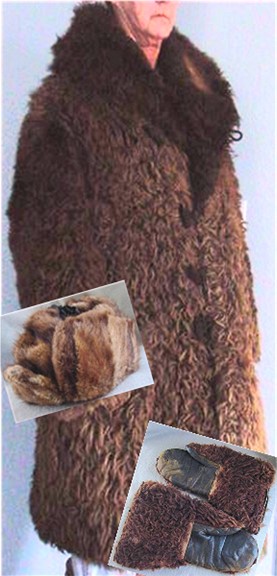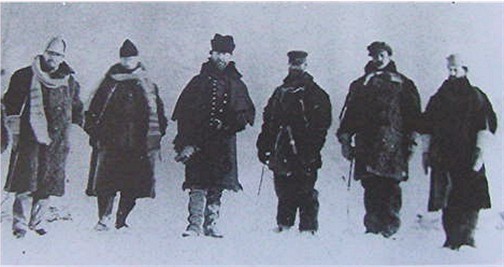|
FRONTIER ARMY OFFICER’S BUFFALO COAT, PATTERN 1879
MUSKRAT FUR HAT, AND BUFFALO MITTENS – IDENTIFIED TO
LIEUTENANT H.M. MILEY, ACTING ASSISTANT SURGEON, US ARMY
- A VERY SPECIAL FRONTIER UNIFORM SET FROM THE INDIAN
WAR PERIOD – ALL IN EXCELLENT CONDITION:
This is a very special
grouping from the estate of First Lieutenant Harry
Melville Miley of Chambersburg, Pennsylvania, who served
as an Acting Assistant Surgeon during the Spanish
American War. This complete winter outer wear set
consisting of a US Army Officer’s Pattern Buffalo Hide
Coat, a pair of Buffalo Hide Mittens, and a Pattern 1879
US Army Muskrat Fur Hat presents in excellent condition,
with the added value of being originally obtained from
the Miley family estate in Chambersburg.

The army was well aware of the need for improvements in
cold weather protection for the troops, particularly for
those serving in the extreme climates of the Western
Frontier where temperatures of 50 below zero were
recorded during campaign conducted by Gen. Miles in the
winter of 1876-77 which resulted in the capture of Crazy
Horse.

JANUARY 1877
Gen.
Miles (center LEFT) & OFFICERS
Cantonment Tongue River
As early as 1875, already concerned for the welfare of
the soldiers, General Meigs, Quartermaster General of
the Army, initiated a survey of the current uniform
being provided to the soldiers, soliciting evaluations
and comments from officers serving in the field
regarding the serviceability and durability of the
uniform currently in use. As a result of the
survey, it was determined that the blanket lined great
coats provided insufficient protection against the
weather encountered throughout much of the frontier and
it was recommended that sheepskin or buffalo coats be
issued.
As was often the case, the soldiers were far ahead of
the decisions of the uniform and equipment boards of the
Quartermaster and Ordnance Departments, and in the case
of clothing themselves against the winter on the
northern plains, many of the officers and enlisted men
had begun to wear buffalo moccasins and coats acquired
through their own efforts.
I
am a firm believer that when confronted with “the
elephant in the room”, the best choice of action is to
remove the peanuts immediately before things get out of
control and the furniture starts being broken. So,
let’s take care of this right from the start….
……..why… exactly…..a young lieutenant – a doctor no less
– would find it necessary, or even a good idea, upon
being appointed to the ranks of an army preparing for
deployment and battle in tropical theaters of war, to
run right out and purchase heavy winter gear is well
beyond our understanding. We simply must accept
that it occurred and that it is part of the historical
record. That Lt. Miley did so, and that he
purchased a very high quality buffalo coat of the
accepted officer’s pattern, matching buffalo hide
mittens, and one of the standard issue Pattern 1879 US
Army Muskrat Fur Hats, and then that he and his
descendants cared for the set and stored it properly to
survive in the excellent condition in which it presents
today, is indeed a fortunate turn of events, especially
for the benefit of modern collectors. This is one
of those circumstances in which the “how” and the “why”
of historical events defies explanation and will forever
remain a mystery.
Dr. Miley was born during the Civil War, on July 24,
1864 in Washington County, Maryland. He received
his medical education much like many other doctors of
the period did, by studying with a practicing doctor and
eventually attending lectures at the Medico Chirurgical
College in Philadelphia, where he graduated with an M.D.
in 1893. He began practicing in a partnership with
the doctor with whom he had studied in Chambersburg,
Pennsylvania. In response to the mobilization for
the Spanish American War, in August of 1898 Miley
received an appointment as an Acting Assistant Surgeon
in the U.S. Army, and was assigned to army hospitals in
Camp Meade, Philadelphia, Pottsville, Lebanon, Reading,
and Baltimore. According to his military records,
Miley contracted typhoid fever and was placed on sick
leave in October of the same year. His service
ended in November of 1898, brief in duration as was that
of so many of the volunteers for this notably short war.
Miley returned to private practice, and during his
professional career served on the Chambersburg Board of
Health, was admitted to the Medical Society, and served
on the staff of the Chambersburg Hospital. Dr.
Miley died March 16, 1938 at the age of 76, and is
buried in the Cedar Grove Cemetery, in Chambersburg,
Pennsylvania. A file of biographic material
detailing the doctor's life will accompany the sale of
this set. The file includes copies of his
appointment as an assistant acting surgeon, his sick
leave, his discharge, and a military patient and
hospital status report he authored during his period of
service.
In spite of his brief period of service during the
Spanish American War, Dr. Miley acquired and retained an
impressive military outfit which was not released from
the family estate until the passing of his heirs in the
1980’s. He kept his dark blue campaign shirt,
khaki trousers, tan campaign hat, dark blue five button
blouse, interestingly - a Krag Rifle and a tan woven web
cartridge belt, and of course this Buffalo Coat set.
While the army never issued a formal description or
specifications for the buffalo coats, it is most likely
the coats were purchased from civilian contractors who
were already engaged in making the coats for the
civilian marketplace.
The pattern of the Enlisted
Men’s coats followed a general style that were ankle
length, double breasted with five sets of large, black,
hard rubber
buttons, each closed with a
twisted cord loop. The
coats were set with two deep slash pockets lined with
dark blue wool. The sleeves and body were lined as
well, some with dark blue and blue-gray wool shirting
and some with heavy brown cotton twill.
The overall cut and styling of the Officer and Enlisted
Men’s coats was basically the same, and this Officer’s
Coat is every bit as heavy and substantial as an
Enlisted Man’s Coat. This Officer’s Buffalo Coat
is identical to the one detailed in Randy Stephan’s
The Horse Soldier, Volume 2, on page 149, Figure
187. The Officer’s Buffalo Coat differs from the
Enlisted Man’s Buffalo Coat in that the officer’s coat
has a quilted polished black cotton lining instead of
the blue wool or brown cotton lining, and the buttons on
the single breasted officer’s coat are cloth covered
wooden toggles rather than the round hard rubber buttons
on the double breasted enlisted version. Its worth
noting that the toggle buttons on this coat are
identical to the style which was used on the regulation
Pattern 1884 Officer’s Woolen Overcoat, which further
confirms this coat as one which would have been
purchased by an officer of the Indian War era.
Having survived the passage of time and years of
storage, this coat presents in excellent condition.
All five of the toggle
buttons and the corresponding corded loops are present.
The fur has retained a
pleasing color and texture without any remarkable
discoloration or fading and the hair is not brittle.
From the coats I have seen in period photos, a certain
amount of rub marks were common where the fur was folded
over on a sharp seam or edge, such as can be seen on the
edges of the collar on this coat.
The visible white line of
hide which demarks the seam or edge is completely
appropriate for these coats and is not evidence of heavy
wear or abuse, but rather the character of working with,
and wearing, buffalo fur. Overall the quality of
the fur on this coat is excellent with no patches of
hair loss and thick curly hair throughout.
All of the seams are intact, the finished edges of the
cuffs, front panels, rear vent, and bottom are all
present, and the lining of the pockets, sleeves and body
is all present and intact with no tearing, mothing or
discoloration. There is very minor wear along the
inside edges of the sleeve cuffs and along the bottom
edge – evidence of having been worn, but not severely.
The inside lower edge of
the right sleeve arm hole has been reinforced with a
period repair of a piece of rounded buckskin which was
sewn over the lining. Note:
Whatever difference in color of the lining you see in
the photographs is a function of variances in lighting
and shadow resulting when you photograph material. The
color of the lining is consistent throughout.
The regulation Model 1879 US Army Winter Muskrat Fur Hat
with this set is an excellent specimen of a uniform hat
which did not survive in great numbers. There are
no tears or seam separation, the hide is still supple,
and there is no loss of fur or wear spots to the hair.
The full length black tie strings attached to the ear
flaps are present. The red wool chintz lining and
grosgrain sweat band present in like new condition, and
apparently this hat was worn very little.
The matched pair of Buffalo Hide Mittens which complete
this set have survived in very nice condition in spite
of signs of obvious use. The fur is overall
completely intact on both mittens save for the area
immediately along the matching edges where the thumb and
index fingers would meet. It occurs to me that the
most likely cause of this wear is the result of holding
a set of reins while riding a horse or driving a wagon
or sleigh, where the reins would work back and forth
through the mittens as the animals were in motion.
The finished black leather palms of both mittens are
soft and supple, showing minor scuffing. Only the
right hand palm shows any significant wear where a small
¼” hole is worn through just below where the tip of the
middle finger would rub against the inside of the
mitten. The mittens are fully lined – with a light
brown wooly surfaced material in the hand sections, and
with a brown corduroy material in the cuffs. The
lining is in overall excellent condition, showing little
evidence of wear except for the point where the lining
is worn through to match the hole in the right palm.
Overall, this is a very nice set that matches the coat.
This complete set is an excellent specimen the type of
protective winter clothing worn by officers serving in
the Frontier Army as they endured temperatures and
conditions far beyond our ability to imagine or
appreciate. A relatively rare set of Indian War
period uniforming, it has the added value of being
identified to an officer of the period - albeit one who
did not serve on the frontier – however, the
identification confirms that this set is the exact
winter clothing worn by officers in the West. None
of these three pieces appear very often on the market in
any condition, particularly since so many of these
coats, hats and mittens were used to destruction or
subjected to the ravages of time in poor storage, and
these three specimens would be almost impossible to
upgrade. This Frontier Officers Buffalo Coat Set
would make a dramatic addition to any Indian Wars
collection.
SOLD
|

